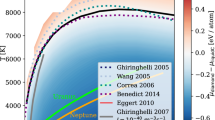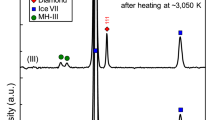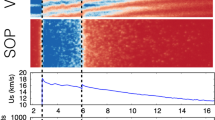Abstract
The pressure and temperature conditions at which precipitation of diamond occurs from hydrocarbon mixtures is important for modelling the interior dynamics of icy planets. However, there is substantial disagreement from laboratory experiments, with those using dynamic compression techniques finding much more extreme conditions are required than in static compression. Here we report the time-resolved observation of diamond formation from statically compressed polystyrene, (C8H8)n, heated using the 4.5 MHz X-ray pulse trains at the European X-ray Free Electron Laser facility. Diamond formation is observed above 2,500 K from 19 GPa to 27 GPa, conditions representative of Uranus’s and Neptune’s shallow interiors, on 30 μs to 40 μs timescales. This is much slower than may be observed during the ∼10 ns duration of typical dynamic compression experiments, revealing reaction kinetics to be the reason for the discrepancy. Reduced pressure and temperature conditions for diamond formation has implications for icy planetary interiors, where diamond subduction leads to heating and could drive convection in the conductive ice layer that has a role in their magnetic fields.
This is a preview of subscription content, access via your institution
Access options
Access Nature and 54 other Nature Portfolio journals
Get Nature+, our best-value online-access subscription
$29.99 / 30 days
cancel any time
Subscribe to this journal
Receive 12 digital issues and online access to articles
$119.00 per year
only $9.92 per issue
Buy this article
- Purchase on Springer Link
- Instant access to full article PDF
Prices may be subject to local taxes which are calculated during checkout





Similar content being viewed by others
Data availability
The datasets used during the current study are available from the corresponding author on reasonable request.
Change history
22 January 2024
A Correction to this paper has been published: https://doi.org/10.1038/s41550-024-02205-y
References
Bethkenhagen, M. et al. Planetary ices and the linear mixing approximation. Astrophys. J. 848, 67 (2017).
Scheibe, L., Nettelmann, N. & Redmer, R. Thermal evolution of Uranus and Neptune—I. Adiabatic models. Astron. Astrophys. 632, A70 (2019).
Qasim, D. et al. An experimental study of the surface formation of methane in interstellar molecular clouds. Nat. Astron. 4, 781–785 (2020).
Benedetti, L. R. et al. Dissociation of CH4 at high pressures and temperatures: diamond formation in giant planet interiors? Science 286, 100–102 (1999).
Hirai, H., Konagai, K., Kawamura, T., Yamamoto, Y. & Yagi, T. Polymerization and diamond formation from melting methane and their implications in ice layer of giant planets. Phys. Earth Planet. Inter. 174, 242–246 (2009).
Kraus, D. et al. Formation of diamonds in laser-compressed hydrocarbons at planetary interior conditions. Nat. Astron. 1, 606–611 (2017).
Cheng, B., Hamel, S. & Bethkenhagen, M. Thermodynamics of diamond formation from hydrocarbon mixtures in planets. Nat. Commun. 14, 1104 (2023).
Lobanov, S. S. et al. Carbon precipitation from heavy hydrocarbon fluid in deep planetary interiors. Nat. Commun. 4, 2446 (2013).
Kolesnikov, A., Kutcherov, V. G. & Goncharov, A. F. Methane-derived hydrocarbons produced under upper-mantle conditions. Nat. Geosci. 2, 566–570 (2009).
Spanu, L., Donadio, D., Hohl, D., Schwegler, E. & Galli, G. Stability of hydrocarbons at deep Earth pressures and temperatures. Proc. Natl Acad. Sci. USA 108, 6843–6846 (2011).
Naumova, A. S., Lepeshkin, S. V. & Oganov, A. R. Hydrocarbons under pressure: phase diagrams and surprising new compounds in the C–H system. J. Phys. Chem. C 123, 20497–20501 (2019).
Ross, M. The ice layer in Uranus and Neptune—diamonds in the sky? Nature 292, 435–436 (1981).
Podolak, M. & Helled, R. What do we really know about Uranus and Neptune? Astrophys. J. Lett. 759, L32 (2012).
Piette, A. A. & Madhusudhan, N. On the temperature profiles and emission spectra of mini-Neptune atmospheres. Astrophys. J. 904, 154 (2020).
Scheler, T. et al. Synthesis and properties of platinum hydride. Phys. Rev. B 83, 214106 (2011).
Frost, M., McBride, E. E., Smith, D., Smith, J. S. & Glenzer, S. H. Pressure driven alkane dehydrogenation by palladium metal. Adv. Mater. Interfaces 10, 2202081 (2023).
Zerr, A., Serghiou, G., Boehler, R. & Ross, M. Decomposition of alkanes at high pressures and temperatures. High Press. Res. 26, 23–32 (2006).
Watkins, E. et al. Diamond and methane formation from the chemical decomposition of polyethylene at high pressures and temperatures. Sci. Rep. 12, 631 (2022).
Hartley, N. et al. Evidence for crystalline structure in dynamically-compressed polyethylene up to 200 GPa. Sci. Rep. 9, 4196 (2019).
Seiboth, F. et al. Simultaneous 8.2 keV phase-contrast imaging and 24.6 keV X-ray diffraction from shock-compressed matter at the LCLS. Appl. Phys. Lett. 112, 221907 (2018).
Zylstra, A. et al. Burning plasma achieved in inertial fusion. Nature 601, 542–548 (2022).
Kraus, D. et al. High-pressure chemistry of hydrocarbons relevant to planetary interiors and inertial confinement fusion. Phys. Plasmas 25, 056313 (2018).
Nestola, F. et al. Impact shock origin of diamonds in ureilite meteorites. Proc. Natl Acad. Sci. USA 117, 25310–25318 (2020).
Zastrau, U. et al. The high energy density scientific instrument at the European XFEL. J. Synchrotron Radiat. 28, 1393–1416 (2021).
Liermann, H.-P. et al. Novel experimental setup for megahertz X-ray diffraction in a diamond anvil cell at the High Energy Density (HED) instrument of the European X-ray Free-Electron Laser (EuXFEL). J. Synchrotron Radiat. 28, 688–706 (2021).
Meza-Galvez, J. et al. Thermomechanical response of thickly tamped targets and diamond anvil cells under pulsed hard X-ray irradiation. J. Appl. Phys. 127, 195902 (2020).
Ball, O. B. et al. Dynamic optical spectroscopy and pyrometry of static targets under optical and X-ray laser heating at the European XFEL. J. Appl. Phys. 134, 055901 (2023).
McWilliams, R. S., Dalton, D. A., Konôpková, Z., Mahmood, M. F. & Goncharov, A. F. Opacity and conductivity measurements in noble gases at conditions of planetary and stellar interiors. Proc. Natl Acad. Sci. USA 112, 7925–7930 (2015).
McWilliams, R. S., Dalton, D. A., Mahmood, M. F. & Goncharov, A. F. Optical properties of fluid hydrogen at the transition to a conducting state. Phys. Rev. Lett. 116, 255501 (2016).
Anderson, O. L., Isaak, D. G. & Yamamoto, S. Anharmonicity and the equation of state for gold. J. Appl. Phys. 65, 1534–1543 (1989).
Zha, C.-S. & Bassett, W. A. Internal resistive heating in diamond anvil cell for in situ X-ray diffraction and raman scattering. Rev. Sci. Instrum. 74, 1255–1262 (2003).
Weck, G. et al. Determination of the melting curve of gold up to 110 GPa. Phys. Rev. B 101, 014106 (2020).
Hubbard, W. Neptune’s deep chemistry. Science 275, 1279–1280 (1997).
Knudson, M. D. et al. Direct observation of an abrupt insulator-to-metal transition in dense liquid deuterium. Science 348, 1455–1460 (2015).
Zaghoo, M. & Silvera, I. F. Conductivity and dissociation in liquid metallic hydrogen and implications for planetary interiors. Proc. Natl Acad. Sci. USA 114, 11873–11877 (2017).
Celliers, P. M. et al. Insulator-metal transition in dense fluid deuterium. Science 361, 677–682 (2018).
Jiang, S. et al. A spectroscopic study of the insulator–metal transition in liquid hydrogen and deuterium. Adv. Sci. 7, 1901668 (2020).
Kraus, D. et al. Indirect evidence for elemental hydrogen in laser-compressed hydrocarbons. Phys. Rev. Res. 5, L022023 (2023).
Correa, A. A., Bonev, S. A. & Galli, G. Carbon under extreme conditions: phase boundaries and electronic properties from first-principles theory. Proc. Natl Acad. Sci. USA 103, 1204–1208 (2006).
Millot, M. et al. Nanosecond X-ray diffraction of shock-compressed superionic water ice. Nature 569, 251–255 (2019).
Weck, G. et al. Evidence and stability field of fcc superionic water ice using static compression. Phys. Rev. Lett. 128, 165701 (2022).
Prakapenka, V. B., Holtgrewe, N., Lobanov, S. S. & Goncharov, A. F. Structure and properties of two superionic ice phases. Nat. Phys. 17, 1233–1238 (2021).
Stanley, S. & Bloxham, J. Convective-region geometry as the cause of Uranus’ and Neptune’s unusual magnetic fields. Nature 428, 151–153 (2004).
Cavazzoni, C. et al. Superionic and metallic states of water and ammonia at giant planet conditions. Science 283, 44–46 (1999).
Redmer, R., Mattsson, T. R., Nettelmann, N. & French, M. The phase diagram of water and the magnetic fields of Uranus and Neptune. Icarus 211, 798–803 (2011).
Soderlund, K. & Stanley, S. The underexplored frontier of ice giant dynamos. Phil. Trans. R. Soc. A 378, 20190479 (2020).
Hörst, S. M. et al. Haze production rates in super-Earth and mini-Neptune atmosphere experiments. Nat. Astron. 2, 303–306 (2018).
Dewaele, A., Torrent, M., Loubeyre, P. & Mezouar, M. Compression curves of transition metals in the mbar range: experiments and projector augmented-wave calculations. Phys. Rev. B 78, 104102 (2008).
Frost, M., Curry, C. & Glenzer, S. Laser cutting apparatus for high energy density and diamond anvil cell science. J. Instrum. 15, P05004 (2020).
Liermann, H.-P. et al. The extreme conditions beamline P02.2 and the extreme conditions science infrastructure at PETRA II. J. Synchrotron Radiat. 22, 908–924 (2015).
Allahgholi, A. et al. AGIPD, a high dynamic range fast detector for the European XFEL. J. Instrum. 10, C01023 (2015).
Allahgholi, A. et al. The adaptive gain integrating pixel detector at the European XFEL. J. Synchrotron Radiat. 26, 74–82 (2019).
Scheler, T., Degtyareva, O. & Gregoryanz, E. On the effects of high temperature and high pressure on the hydrogen solubility in rhenium. J. Chem. Phys. 135, 214501 (2011).
Maltezopoulos, T. et al. Operation of X-ray gas monitors at the European XFEL. J. Synchrotron Radiat. 26, 1045–1051 (2019).
Dewaele, A., Fiquet, G. & Gillet, P. Temperature and pressure distribution in the laser-heated diamond-anvil cell. Rev. Sci. Instrum. 69, 2421–2426 (1998).
Husband, R. J. et al. X-ray free electron laser heating of water and gold at high static pressure. Commun. Mater. 2, 61 (2021).
He, Z. et al. Diamond formation kinetics in shock-compressed C–H–O samples recorded by small-angle X-ray scattering and X-ray diffraction. Sci. Adv. 8, eabo0617 (2022).
Wang, X., Scandolo, S. & Car, R. Carbon phase diagram from ab initio molecular dynamics. Phys. Rev. Lett. 95, 185701 (2005).
Nettelmann, N. et al. Theory of figures to the seventh order and the interiors of Jupiter and Saturn. Planet. Sci. J. 2, 241 (2021).
Acknowledgements
We thank N. Hartley for fruitful discussions. This work was supported by US Department of Energy (DOE) Office of Fusion Energy Sciences funding no. FWP100182. A.F.G. and E.E. are grateful for the support of Carnegie Science and NSF EAR-2049127. We acknowledge European XFEL in Schenefeld, Germany, for provision of X-ray free-electron laser beamtime at Scientific Instrument HED and thank the staff for their assistance. We acknowledge DESY (Hamburg, Germany), a member of the Helmholtz Association HGF, for the provision of experimental facilities. Parts of this research were carried out at PETRA III beamline P02.2. Beamtime was allocated from in-house beamtime from the beamline. Lawrence Livermore National Laboratory is operated by Lawrence Livermore National Security, LLC, for the US DOE, National Nuclear Security Administration under Contract DE-AC52-07NA27344. S.N. and L.M.A. acknowledge financial support from Sorbonne University under grant Emergence HP-XFEL. Y.L. is grateful for support from the Leader Researcher programme (NRF-2018R1A3B1052042) of the Korean Ministry of Science and ICT (MSIT). We are indebted to the HIBEF user consortium for the provision of instrumentation and staff that enabled this experiment. G.M. has been supported by a grant from Labex OSUG@2020 (Investissements d’avenir - ANR10 LABX56) and PNP-INSU programme. M.B. acknowledges the support of Deutsche Forschungsgemeinschaft (DFG Emmy-Noether project BY112/2-1).
Author information
Authors and Affiliations
Contributions
All authors were involved in experimental planning. M.F., E.B., M.B., R.J.H., C.S., H.-P.L., Z.K. and A.F.G. coordinated the experiment. M.F. prepared the samples. H.-P.L., J.D.M., L.M.A., S.K. and B.M. performed the prescreening at P02.2 at PETRA III. M.F., C.S., C.B., H.-P.L., Z.K., S.N., J.D.H., C.P., E.E., R.S.M., S.C., O.B.B., M.J.D. and A.F.G. conducted the experiment. T.L., S.S., C.S. and J.S.-D. operated the AGIPD detector. R.R., S.H.G. and A.F.G. advised. M.F., R.S.M., O.B.B., R.J.H., Z.K., C.P., E.E. and A.F.G. analysed the data. M.F. and R.S.M. wrote the paper.
Corresponding author
Ethics declarations
Competing interests
The authors declare no competing interests.
Peer review
Peer review information
Nature Astronomy thanks the anonymous reviewers for their contribution to the peer review of this work.
Additional information
Publisher’s note Springer Nature remains neutral with regard to jurisdictional claims in published maps and institutional affiliations.
Extended data
Extended Data Fig. 1 FEA Model of Sample Temperature.
FEA model (cylindrical section) of sample temperature at the time of XFEL probing at 30 μs in Fig. 3d. Bold white lines indicate boundaries between DAC components; light white lines indicate additional boundaries required by the analysis; XFEL radiation is from below26. Black lines indicate solid-liquid boundaries, with the melting point of Au taken to be 2350 K31,32 and the melting point of polystyrene taken to be 1000 K (representing a likely minimum bound, considering an ambient melting point of 510 K and steep rise with pressure). The model shows high temperatures are localized near the coupler hole, with cold material surrounding the hotspot, including several microns of cold and solid polystyrene separating the sample from the diamond anvils and significantly more separating the hot sample from the gasket.
Extended Data Fig. 2 Time resolved data from a run with 1% beam power.
No thermal emission or diamond is observed. a: XRD in region of interest, vertical stripes are artifacts from diode normalization. b: SOP spectrogram showing no emission. c: Time evolution of intensity at q where diamond is expected shows no diamond formation, the line is smoothed with 15 pulse wide Hamming window. Time 0 is estimated first arrival of X-rays based on other runs.
Extended Data Fig. 3 Time resolved data from a run with 5% beam power.
Thermal emission and diamond formation are observed. a: XRD in region of interest normalized to beam intensity monitoring diode. The diamond 111 reflection is visible after 40 μs. b: SOP spectrogram. c: Temperature from SOP fitting and equation of state of gold30. d: Time evolution of diamond peak intensity, line is smoothed with 15 pulse wide Hamming window. Time 0 corresponds to first X-ray pulse based on rising edge of thermal emission. Temporal error bars represent the time bin of the SOP, temperature error bars represent one-half standard deviation confidence and are derived from the fitting uncertainty of a Planck function to the spectrographic data and statistical analysis of these data27.
Extended Data Fig. 4 Time resolved data from a run with 25% beam power.
This is a different run than is presented in Fig. 3, but shows similar temperatures and diamond formation. a: XRD in region of interest normalized to beam intensity monitoring diode. The diamond {111} reflection is visible after 35 μs. b: Emissivity as a function of time. c: SOP spectrogram. d: Temperature from SOP fitting and equation of state of gold30. e: Time evolution of diamond peak intensity, line is smoothed with 15 pulse wide Hamming window. Time 0 corresponds to first X-ray pulse based on rising edge of thermal emission. Temporal error bars represent the time bin of the SOP, temperature error bars represent one-half standard deviation confidence and are derived from the fitting uncertainty of a Planck function to the spectrographic data and statistical analysis of these data27.
Extended Data Fig. 5 Unintegrated Diffraction Image.
Raw diffraction pattern from a single XFEL pulse taken 40.2 μs into a run starting at 19 GPa. The SOP temperature is 2540(30) K. The integrated pattern is shown in Fig. 4b. λ = 0.6965 Å. Lighter shades correspond to higher signal, brightness and contrast are optimized for visibility. The pattern is azimuthally unwrapped such that vertical lines are at constant q (also known as ‘caked’). The shadow at low q is from the mirror used to observe the sample, the dark panel (top right) was faulty and masked when integrating the diffraction patterns.
Supplementary information
Supplementary Information
Supplementary Figs. 1–11, Tables 1 and 2, and minimal supporting text to contextualize these.
Rights and permissions
Springer Nature or its licensor (e.g. a society or other partner) holds exclusive rights to this article under a publishing agreement with the author(s) or other rightsholder(s); author self-archiving of the accepted manuscript version of this article is solely governed by the terms of such publishing agreement and applicable law.
About this article
Cite this article
Frost, M., McWilliams, R.S., Bykova, E. et al. Diamond precipitation dynamics from hydrocarbons at icy planet interior conditions. Nat Astron 8, 174–181 (2024). https://doi.org/10.1038/s41550-023-02147-x
Received:
Accepted:
Published:
Issue Date:
DOI: https://doi.org/10.1038/s41550-023-02147-x



